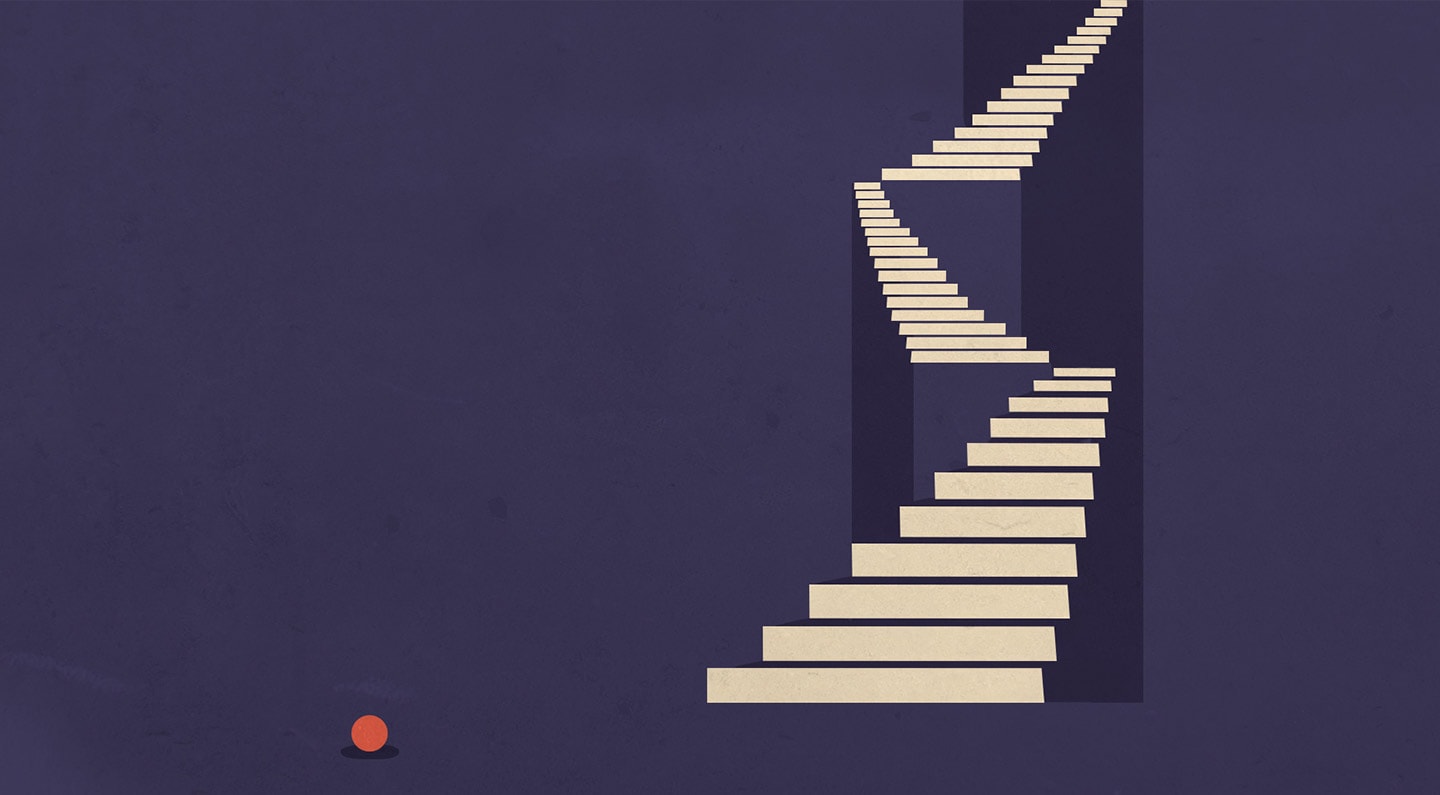
What’s it really like to go through an intensive “bootcamp” course online?
To find out, we asked School of Motion for one seat in their Design Bootcamp class, which we would award to a lucky student. In turn, that student would share an honest journal of their experience on Motionographer.
After combing through dozens of applicants, we had our winner, Bruna Cremm Roteger Estaiano. What follows is her account of the summer 2016 session of School of Motion’s Design Bootcamp led by Michael Frederick. Enjoy.
Note: School of Motion is migrating to a new platform. The spirit and content of the course are unchanged, but many improvements have been made over the last year.
Week 01
When you first log in your student portal, you are welcomed with a friendly reminder of how your life is going to be:

And they were right: this first week was hard. There were a lot of videos to watch and information to absorb across numerous subjects.
It was also hard because of the first assignment: You’re expected to design frames for a TV promo (for a real brand, with briefs and specific assets you must use), even if you know nothing about design. The objective of this exercise is to evaluate your design knowledge prior to the course.
The course takes a “hands-on” approach, and you feel it right away. As I was designing my frames, I had this feeling that my mind was “blocked.” I couldn’t get across that first blank Photoshop layer, and I was taking a lot longer to design things than I wanted to.

Here’s my first attempt at the TV promo
But I was excited to share my work with my classmates and get critiques from so many talented people (your teachers and colleagues included). Everyone is participative, and we’re always trying to help each other by giving our opinion or sharing personal techniques.
As you post your work, you start to absorb all this feedback and knowledge directed at you, and then — without even noticing it — your designs start to improve a lot faster than before.

My second attempt
Take my second design attempt as an example: It’s still not as perfect as I wanted, but I can see improvement after only only five days.
We were also told that orientation week was just a “warm up,” that next week would be even harder and that our social lives would probably take a hit or two. I can’t wait.
Week 02
Week 02 was all about typography and composition. Our assignment was to create TV promo boards, including a logo. We started with the logo and learned about kerning, alignment, contrast and value within typefaces (and many other neat tips I had no idea about).
A lot discussion for the course takes place via the course’s Facebook group. While it is a great tool that keeps everyone engaged, it gets somewhat hard to follow all the updates, notifications and critiques from colleagues. I kept browsing it to see if I missed someone´s work that I wanted to check out.
Back to the assignment: After designing the logo, we tackled the promo boards.

To show us how he goes about creating boards for a client, Michael (the lead instructor) records himself doing a full set of boards from start to finish. It’s 176 minutes of board creation (!). Even though the content was great, it was hard for me to maintain focus.
We can fast-forward the videos, but I didn’t want to miss a thing. So I “endured” it all. It was so great to see the way how Michael’s mind operates and how he goes about each little thing. There were a lot of little tricks I’ll be using now. I loved it.
All in all, week 02 had a much faster pace than week 01, but things are slowly starting to “click” now. Here’s hoping my brain hurts a little more next week. :)
Week 03
Joey Korenman talks about Impostor Syndrome on the School of Motion blog, and I can tell you now that is very real. This week, we had to design multiple style frames for a NASA TV show, then choose one of the styles and create a full set of six boards.
I felt stuck the whole week. While everyone seemed to come up with awesome boards and continuously post them on Facebook, I kept having a really hard time making just two different style frames.

At one point, I even felt that this course wasn’t for me, since I couldn’t keep up with everyone’s speed and didn’t know which of the styles I should choose to make the new boards. That was on Friday. Coincidentally, on the same Friday, our daily class was named “The Blank Page Problem,” and Michael made a podcast entitled, “Do the work.”
It was incredibly helpful, as I was going through everything he was saying: Frustration, procrastination (due to frustration) and so on. After I finished the podcast, I got really inspired and managed to finish in one day what I couldn’t in four days. By the end of the weekend, I had chosen my key styleframe (changed a few things, too, based on feedback from my teacher assistant) and finished the full set of 6 boards.

Week 04
Week 04 was our first “Catch Up” week. While we did have new content (including a podcast from Joey, reading material about developing good taste, and a bonus video on art history), we didn’t have new assignments this week. We could focus on reviewing and perfecting our previous projects with the help of our Teacher Assistants.
I decided to focus on reviewing my NASA assignment, and I’m pretty happy with the results. There are obviously more things that I would tweak, but it’s time move on to another project.

Imposter Syndrome is still lurking on my mind, but with everyone’s help, I’m slowly becoming more confident about my work. Before taking the course, there was this constant feeling of being completely stuck and that my work was not progressing, but now I can see a light at the end of the tunnel.
Week 05
This week, we stepped away from design lessons to learn a bit more about art direction: What it really is versus what people think it is.
There’s no universally accepted definition. As the teachers said, this lesson was only the tip of the iceberg as far as art direction goes, but it did show us how to conceive of an effective mood for a specific project through the use of moodboards and mind mapping. I didn’t know the mind mapping technique and found it quite useful for those moments where you don’t know what to do.
To grasp art direction as a whole, we had to art direct (and design) for an electronic dance music festival. It was one of my favorite assignments so far. I found it very fun.
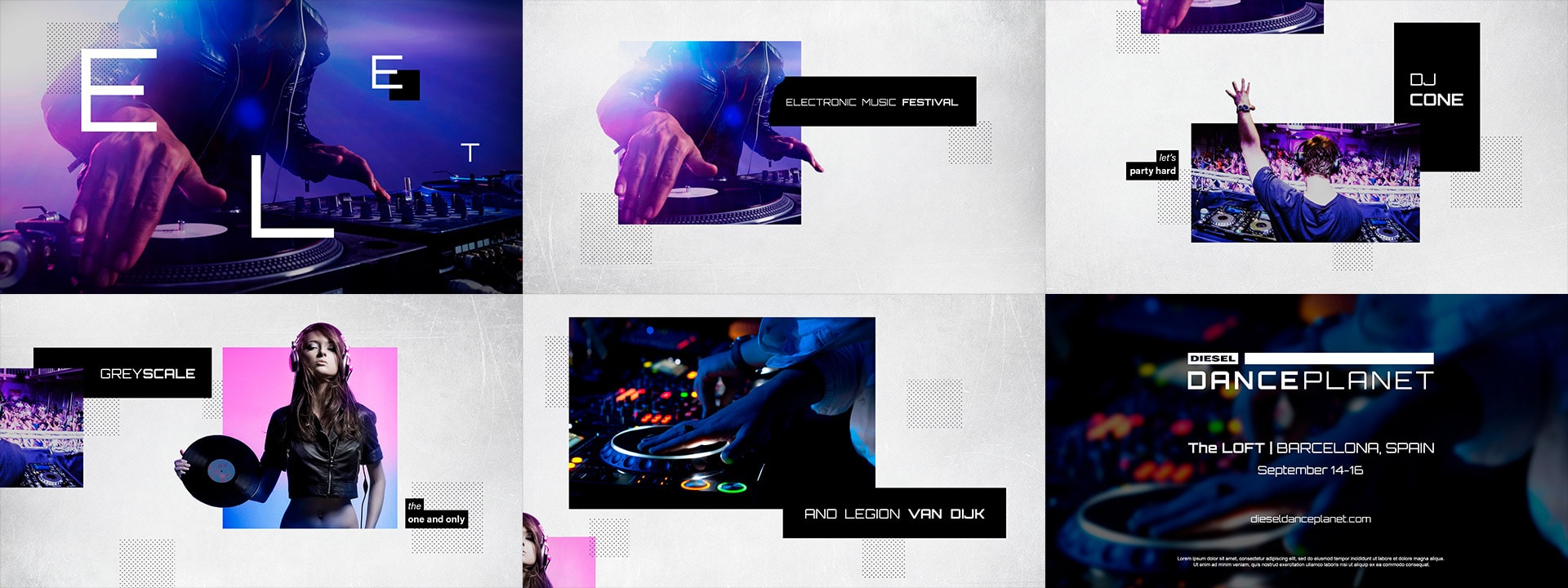
Week 06
Every week is an adventure at Design Bootcamp and Week 06 was no different.
This time, our assignment was to design some frames for a horror movie trailer. I must say that while the last assignment was one of my favorites, this wasn’t for me. I try to avoid horror movies, because I’m such a coward. But to work on projects we don’t like is also part of our profession.
We had restrictions on this assignment: don’t color correct the movie we’re advertising, follow the color palette, and make it mysterious/scary.
After banging my head on the work desk for four days due to lack of ideas (good or bad, I just couldn’t think of anything) I finally managed to get something done at the last possible minute. I really wanted to deliver the frames on time, so I worked overnight to do so, even if I wasn’t 100% satisfied with the result.

Delivering frames on time is important because, as Emilia (the teacher assistant from my class) said, we must try our best to deliver the assignment on time even if we don’t like the result. It’s the only way to get critique/feedback on it.
It doesn’t really matter if you spend weeks perfecting that one frame but fall behind on the other assignments and can’t keep up with the class. That’s why SoM created catch up weeks, so students can go back on the projects they want while staying focused on the current assignments.
Another good reason to deliver them on time is because you have a chance to have your work analyzed/tweaked/critiqued live by Michael and the other teachers at The Woodshed, a weekly internal show that runs every wednesday during the whole Bootcamp. For the show, Michael chooses one student PSD to tweak, showing how he would have designed it.
The another assignment that was given this week was to design an explainer video. The amount of variety we have in terms of types of tasks we have to do is so, so great. We jump from a TV promo to a horror movie trailer to an explainer video so quickly. It’s intense, but at the same time so refreshing to do so much different stuff.

Frames from the explainer video. We had a limited color palette of four colors.
I’d also like to note that at the beginning of Bootcamp, most of us students were not very sure of our own capabilities or if we had what it takes to be a good designer. But now, as we saw everyone getting better together, there was this collective confidence building up. We were really starting to get a grip of things.
Week 07
Our second catch-up week. A much needed one, as it feels like I just ran a marathon!
In the middle of the week, I got a pretty strong flu and couldn’t focus on anything. So I decided to use the catch-up week to take it slower, relax and get well.
But that doesn’t mean I’ve got nothing to say about this week. As always, Michael and Joey left great content for us to listen to.
This week was named “career talk,” with two podcasts on the topic. The first was a one-hour interview with Ted Roberts from Viewpoint Creative, a studio that’s long produced great design, like their “Nat Geo: We Steal Secrets” promo. Ted talks about what it’s like being a creative director at a large studio and also says what he is looking for in up-and-coming artists.
The other podcast was about designers versus animators. It covered the differences between the two roles, what it’s like being a motion designer, and the need to balance both sides of the work (i.e. design and animation).
I can’t say much more or I’ll spoil it for you, but this content was great.
Week 08
I got over the flu, and for that I’m thankful, because this week was the hardest one yet.
There were two projects to work on, and both were very challenging in different ways. The first project was designed to make us work with 3D elements for the first time. We had the option to do the 3D ourselves (Joey provided a 1h 30m crash course in Cinema 4D for that) or, if we didn’t have much time, you could work some basic renders they provided for us.
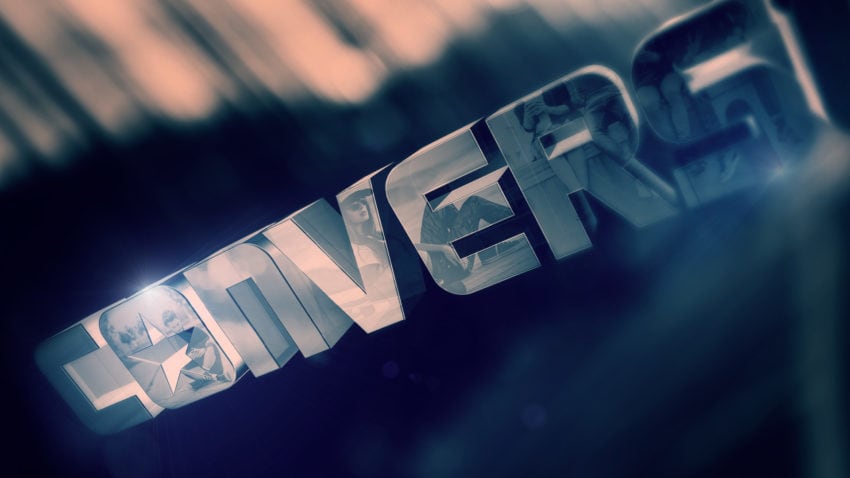
One of my frames for the 3D assignment
As always, we first watched Michael work on his designs. As he worked, he said something that “glued” into my mind.
Michal said that he was not a 3D artist by any means, but that he did “force” himself to learn at least the basics of 3D because as a generalist designer, the more tools he could use, the better. Knowing 3D would expand his opportunities.
It was interesting to hear that because it got me thinking about one of the biggest dilemmas we have as artists: Should you be a generalist or a specialist?
Lucky for me, this was the subject of another great podcast from Michael. He explained the pros and cons of both paths and also talked about his story, how he started and how he decided that he wanted to be a generalist.
The podcast was really useful, but I admit I still have doubts on what to follow. Right now, I’m a generalist, but I’m unsure if that’s what I want to be, like, “forever.” :)
After the 3D assignment, we had our biggest project yet. We had to deliver a minimum of 12 boards (but the average, according to School of Motion) would be around 24 boards. The assignment was to design a complete explainer video for IBM.
We’d have a whole week to finish it as opposed to the usual 3-4 days per assignment. Still, it wasn’t enough for me. This assignment was hard. This was also the first project I couldn’t finish on time. (That makes me sad. I really wanted to be able to deliver everything on time.)
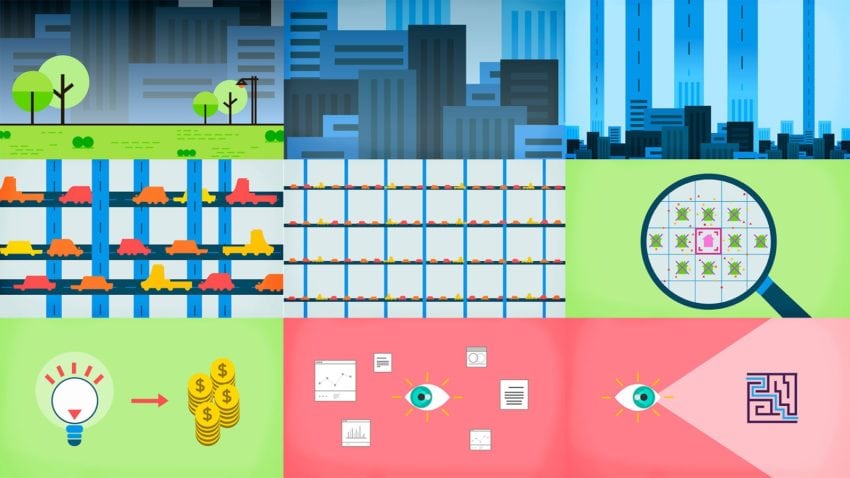
First set of boards. I ended up with 18.
This project was a little different from others, where we did all the work by ourselves. With this project, we had illustrations provided by Brian Gossett. They were all in grayscale, and we had to adapt the colors to the IBM brand while also creating new objects and frames — all following Brian’s initial visual language.
We also got the chance to see Michael working on the boards, step by step, for about three hours of footage. It was great. So many new tricks, so little time! Michael works with so much focus and so smoothly. He makes it looks easy!
Week 09
This week, we finished our IBM boards. Have I said this assignment was hard already? Because it was. Oh, my head still hurts. But I did learn a lot in the process, so it was worth it.
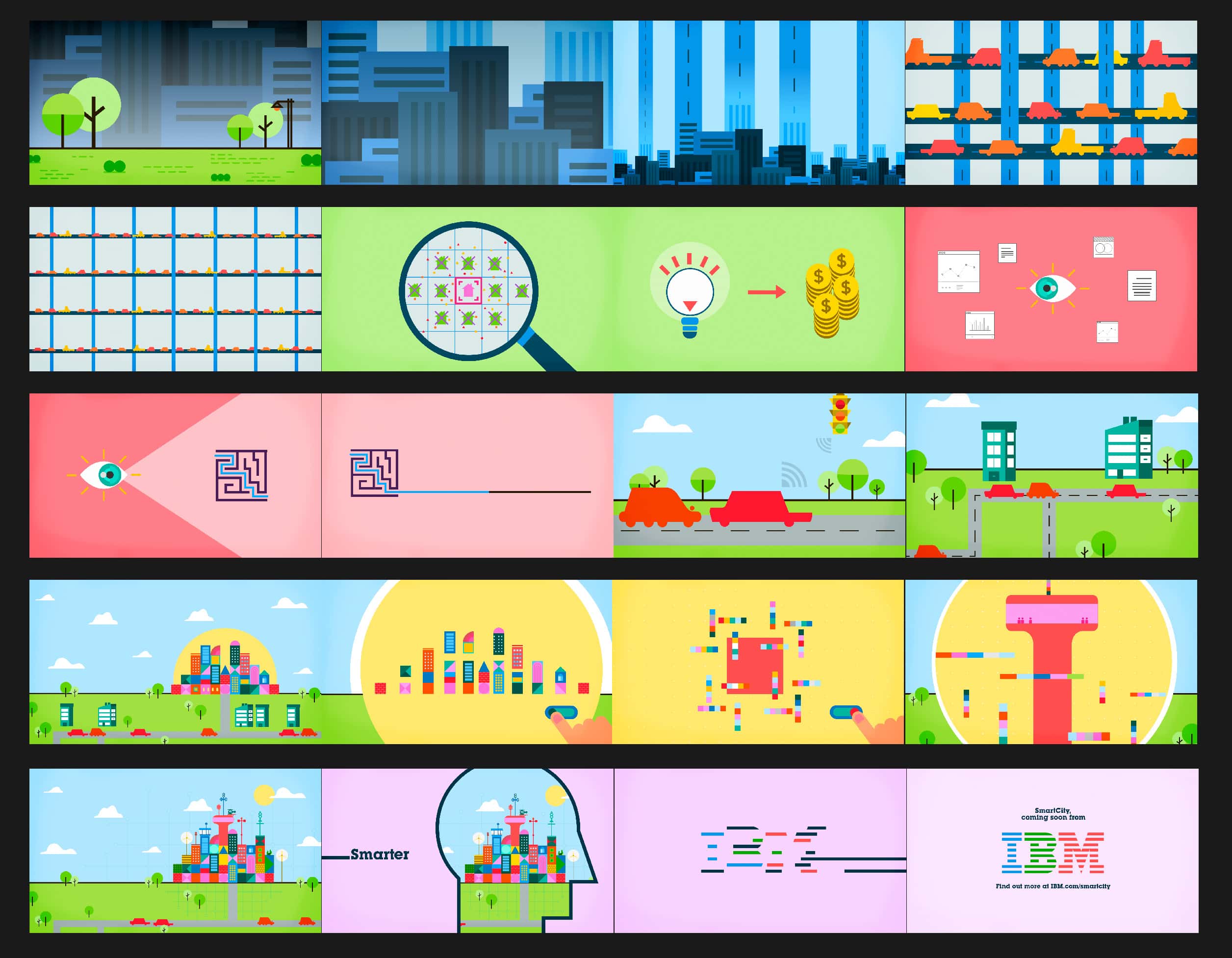
Most of the learning comes from the constant support that your teacher assistants and colleagues provide. I can’t say how many times Emilia Metzel (my TA) helped me out on things that I’d never see on my own. Same with my study buddies. They gave excellent critiques!
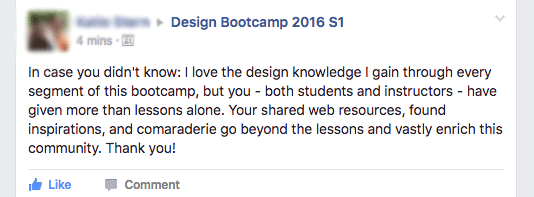
Our study group was full of love. :)
This week also marked the beginning of the final project named appropriately, “Final Boss.” It was a massive project for Premium Beat Music Library, and we were provided with more than 10gb of material from Premium Beat itself.
This assignment was very different from the previous ones. On every previous project, we would see lessons of Michael working on a similar project before starting on our own. However, for this final project, Joey said that Michael had already given us enough knowledge to tackle a full project by ourselves.
We also had no deadline. We had finish the project when we can, so we could take our time to give it our very best. I planned on finishing it on the second critique week, so I can have another full week of refining and tweaking it.
I learned so much more about design in these few weeks than I did in all of college.
“Wait… final project? Critique weeks? What? Nooo, this can’t be happening!”
Yep. Design Bootcamp was officially over. On Week 9, we had our final lessons. We had three more weeks of extended critique to submit any project we wanted for review, but the lessons were over.
I learned so much more about design in these few weeks than I did in all of college. I’m gonna miss the lessons and mentorship a lot, but Michael has given us enough knowledge to “fend for ourselves” now, and for that, I’m grateful.
But it isn’t over yet! We still have three more weeks of review, and I’m gonna use them as much as I can!
Week 10, 11 & 12: Critique weeks
After Design Bootcamp lessons ended, things slowed down a lot.
While our teachers were there for us, ready to help us out on anything, the Facebook group got a lot quieter. Everyone was focused on finishing as many assignments as they could. I focused on finishing the final project. I really wanted to finish all assignments that were given.
I decided to make the Premium Beat spot fully 3D and use the rest of the week to model some objects while searching some other free objects on the web. I’d model everything myself if I could, but time was running out.
In the middle of week two, I realized that I’d miscalculated the render times and there was a possibility I wouldn’t finish on time. I sent a work-in-progress to my teacher, Emilia, to get some review/critique on it, rather than none. Emilia spot on with the feedback, and I changed a lot of things.

Here’s one of the initial frames.
On week three, it was decided: I wouldn’t finish the project on time, unless I only slept like three to four hours a day.
And so I did that.
The nights were long and tiring, but I managed to deliver the final project on Friday, the last day possible. It was a tough, fun project that taught me a lot about time management.
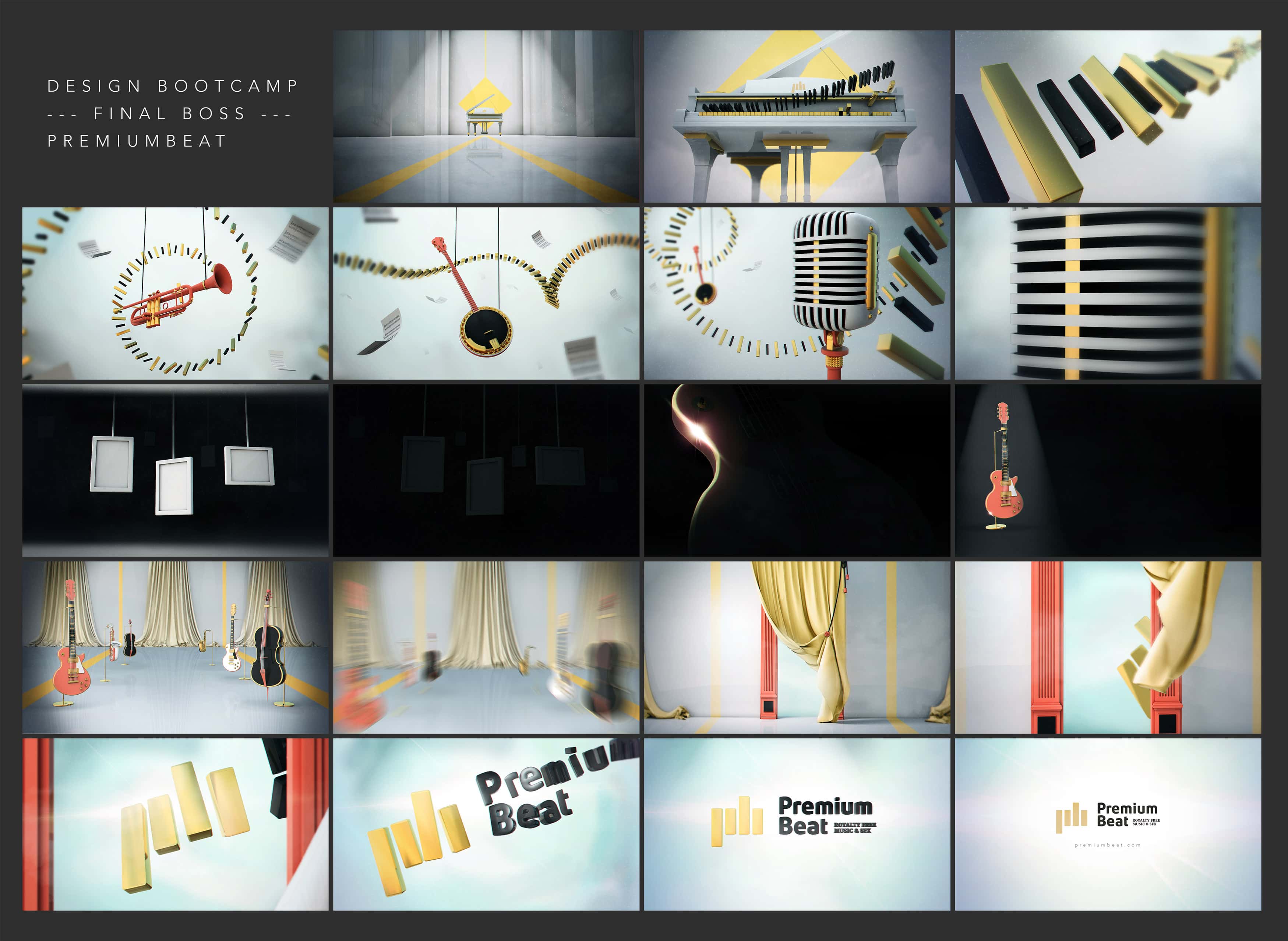
I’ve uploaded all my projects on a new portfolio: brucremm.myportfolio.com.
All in all, I’m really going to miss Design Bootcamp — the teachers, my new colleagues… everything was an amazing experience, and I’m glad that I was able to be a part of it!






